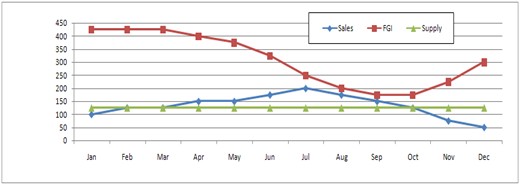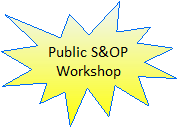
Copyright © 2009 by J. E. Boyer Company, Inc. · All Rights reserved · E-Mail: jeb@jeboyer.com


S&OP Executive Overview ...
In today’s competitive manufacturing environment, there is no time to compete with ourselves. The sales department is not manufacturing’s enemy and vice versa. If we waste time trying to figure out how we can “get them next time”, our competition will surely “get us”. To quote the famous astronomer and scientist Carl Sagan, “an organism at war with itself cannot survive”. To rise above this classic sales vs. operations bickering, the survivors and the successful manufacturing companies are taking an approach of cooperation and teamwork. They recognize that the “enemy” is the competitor, not each other. They know that all management energy in the business must be channeled into making smart fact-based timely decisions that will trill customers, reward shareholders, attract talent, and please their economic surroundings. The bottom line to the company is normally sales growth, reduced production costs, and optimized asset use.
So what is the magic? Truth is … there is no magic … no silver bullet. But there are proven management practices being used today that help organizations achieve the cooperation and teamwork that provide a fighting chance to win. One of these is called Sales and Operations Planning, or S&OP for short. We call it top management’s handle on the business … an activity for effectively balancing demand and supply on a regular and formal basis through an appropriate planning horizon and level of detail. It requires the sales people to describe what they believe the business will sell, and operations people to describe what the business will supply. The difference between the two is the change in inventory investment.
So why balance demand and supply? Suppose demand becomes greater than supply … what happens? Overtime … allocations … outsourcing … premium freight … to name a few. Most of the time, the cost of doing business goes up and customers are not happy. Now suppose supply becomes greater than demand … what happens? Underutilized fixed cost … excess inventory … reduction in force expense … to name a few. Again, costs will rise. Those who study these situations agree that either way, costs rise when demand and supply are out of balance. But when they are in balance the company has the best chance of operating at the lowest cost base, shipping product on time, and minimizing the inventory investment.
We have learned over the years that S&OP is the “practice of choice” that enables the demand and supply balancing activity. It gets sales people and operations people working together and on the same page. It creates an environment where all functions (sales and marketing, manufacturing, materials, finance and accounting, engineering, information technology, and human resources) together are improving business performance, not trying to bury each other! A formal S&OP process provides formats, data, structure, timelines, facts, and agendas for building an accountable decision making group. It replaces fragmented opinion based foxhole management tactics that drive us to self competition.
Interested? Here’s how a typical 8-step S&OP process works:
Step 1: Report Actuals - Day 1. At the close of business at the end of the month we need to know bookings (orders in), shipments (orders out), backlog, inventory, and supply. These are actual … there is a right answer to each of the five. And the data must be categorized in a variety of ways depending on the function. Perhaps by customer for sales and by production line for operations. This isn’t as easy as you think. Have you ever been to the meeting where all you talked about was who had the right number?
Step 2: Forecast Sales - Day 1. This is the job for the sales team. They must tell the company in the proper level of detail what sales are going to be in terms of units and average selling price through an appropriate horizon … usually 12 months. Each sales person generally does this by key account, key product group, and an “other” category.
Step 3: Aggregate Sales Data - Day 1. Input from all of the individual sales sources must be aggregated so further collective analysis can be done. Many times this is a system activity, but sometimes is done manually.
Step 4: Review Corporate Sales - Day 2. Once the data is in a fit-for-use condition, the sales team (chaired by the VP of Sales), meets to review the sales forecast. Any required adjustments are made and assumptions are documented. The output is the approved company sales forecast.
Step 5: Develop Supply Plans - Days 3-4. The S&OP Coordinator takes the sales forecast and creates a first-cut supply plan that includes considerations for backlog, targeted inventory positions, the shipment plan and any anticipated material and/or capacity constraints.
Step 6: Review Corporate Supply - Day 4. The VP of Operations assembles his/her team to review the supply plan. They will deal with material and capacity issues, ensure that the inventory plan is correct, and set the output rates by plant and by supply line/cell.
Step 7: Conduct the S&OP Meeting - Day 5. The company President chairs this 2-hour meeting with his/her staff plus a few others including the S&OP Coordinator. Here, any high level issues are dealt with and the plans for bookings, backlog, shipments, inventory, and supply are finalized.
Step 8: Monitor Progress - Daily. After the S&OP meeting is complete, it is critical that each and every person who makes decisions from S&OP information has access to it. Plus, each person who provided input (sales, inventory, supply) has a method to compare actual vs. forecast/plan at any time during the month. This feedback provides a real-time opportunity for making decisions that will help achieve the plan.
Sounds easy, doesn’t it? Actually it all makes common sense. There is nothing fancy about it. But is does take some work. It takes dedication. It cannot be optional. The players … like it or not … must play! One time in a meeting with one of my clients a vice president had heard enough whining from the troops about having to forecast and go to meetings and work with data and … and … and. He stood up, got red in the face and said “Enough! This is something that we are going to do! There is going to be no more talk about whether or not we are going to do it … but we’ll talk all you want about HOW we are going to do it. Plus … I promise you I will carry the wounded, but I’ll shoot the stragglers!” Silence came to the room. He took a breath, calmed down a bit, and went on to say “Guys, this is fundamentally a high performance communication process. Remember, at the end of the day, we all have the right to know everything that we all know”. We moved on from there and developed a very successful S&OP process.
That story aside, there are really four keys that make S&OP successful:
Key Number 1: Show Up! It is absolutely critical that each and every player in the process shows up dressed to play. They must be at the required meetings, have their data and analysis ready on time, and do their homework so when they are in a meeting they are prepared to present their information and field questions. Following this key gives S&OP a fighting chance to succeed. Not showing up ensures failure!
Key Number 2: Flawless Data! Every piece of data and information must be mined to perfection and presented without error. Remember … for “actuals” there is a right answer! Plus the date must be presented absolutely professionally. The S&OP documents must look good and be understandable.
Key Number 3: One-Plan-Process! When someone asks a question like “what will shipment be for the next 12 months”, the S&OP document must provide the answer. If people are reaching for a different document, then there is a multi-plan process. The goal is to have one set of facts that the entire team uses. Plus, the output of the S&OP process must flow seamlessly down through the ERP system to ensure that detailed part number decisions are consistent with S&OP direction. This can be quite a bit of work … but must be done!
Key Number 4: Top Management! Without the top management players showing up and doing their part, S&OP will be optional to other team members and the process will be ineffective. Face it … the top management team thinks about all of the S&OP subject matter all of the time anyhow, so why not just do it within the framework of the S&OP process? Come on top management … do you part! Your team needs you!
So there you have it. A proven methodology for getting sales and operations on the same page and working together. It’s call Sales and Operations Planning. I wish you the best on your journey!
In today’s competitive manufacturing environment, there is no time to compete with ourselves. The sales department is not manufacturing’s enemy and vice versa. If we waste time trying to figure out how we can “get them next time”, our competition will surely “get us”. To quote the famous astronomer and scientist Carl Sagan, “an organism at war with itself cannot survive”. To rise above this classic sales vs. operations bickering, the survivors and the successful manufacturing companies are taking an approach of cooperation and teamwork. They recognize that the “enemy” is the competitor, not each other. They know that all management energy in the business must be channeled into making smart fact-based timely decisions that will trill customers, reward shareholders, attract talent, and please their economic surroundings. The bottom line to the company is normally sales growth, reduced production costs, and optimized asset use.
So what is the magic? Truth is … there is no magic … no silver bullet. But there are proven management practices being used today that help organizations achieve the cooperation and teamwork that provide a fighting chance to win. One of these is called Sales and Operations Planning, or S&OP for short. We call it top management’s handle on the business … an activity for effectively balancing demand and supply on a regular and formal basis through an appropriate planning horizon and level of detail. It requires the sales people to describe what they believe the business will sell, and operations people to describe what the business will supply. The difference between the two is the change in inventory investment.
So why balance demand and supply? Suppose demand becomes greater than supply … what happens? Overtime … allocations … outsourcing … premium freight … to name a few. Most of the time, the cost of doing business goes up and customers are not happy. Now suppose supply becomes greater than demand … what happens? Underutilized fixed cost … excess inventory … reduction in force expense … to name a few. Again, costs will rise. Those who study these situations agree that either way, costs rise when demand and supply are out of balance. But when they are in balance the company has the best chance of operating at the lowest cost base, shipping product on time, and minimizing the inventory investment.
We have learned over the years that S&OP is the “practice of choice” that enables the demand and supply balancing activity. It gets sales people and operations people working together and on the same page. It creates an environment where all functions (sales and marketing, manufacturing, materials, finance and accounting, engineering, information technology, and human resources) together are improving business performance, not trying to bury each other! A formal S&OP process provides formats, data, structure, timelines, facts, and agendas for building an accountable decision making group. It replaces fragmented opinion based foxhole management tactics that drive us to self competition.
Interested? Here’s how a typical 8-step S&OP process works:
Step 1: Report Actuals - Day 1. At the close of business at the end of the month we need to know bookings (orders in), shipments (orders out), backlog, inventory, and supply. These are actual … there is a right answer to each of the five. And the data must be categorized in a variety of ways depending on the function. Perhaps by customer for sales and by production line for operations. This isn’t as easy as you think. Have you ever been to the meeting where all you talked about was who had the right number?
Step 2: Forecast Sales - Day 1. This is the job for the sales team. They must tell the company in the proper level of detail what sales are going to be in terms of units and average selling price through an appropriate horizon … usually 12 months. Each sales person generally does this by key account, key product group, and an “other” category.
Step 3: Aggregate Sales Data - Day 1. Input from all of the individual sales sources must be aggregated so further collective analysis can be done. Many times this is a system activity, but sometimes is done manually.
Step 4: Review Corporate Sales - Day 2. Once the data is in a fit-for-use condition, the sales team (chaired by the VP of Sales), meets to review the sales forecast. Any required adjustments are made and assumptions are documented. The output is the approved company sales forecast.
Step 5: Develop Supply Plans - Days 3-4. The S&OP Coordinator takes the sales forecast and creates a first-cut supply plan that includes considerations for backlog, targeted inventory positions, the shipment plan and any anticipated material and/or capacity constraints.
Step 6: Review Corporate Supply - Day 4. The VP of Operations assembles his/her team to review the supply plan. They will deal with material and capacity issues, ensure that the inventory plan is correct, and set the output rates by plant and by supply line/cell.
Step 7: Conduct the S&OP Meeting - Day 5. The company President chairs this 2-hour meeting with his/her staff plus a few others including the S&OP Coordinator. Here, any high level issues are dealt with and the plans for bookings, backlog, shipments, inventory, and supply are finalized.
Step 8: Monitor Progress - Daily. After the S&OP meeting is complete, it is critical that each and every person who makes decisions from S&OP information has access to it. Plus, each person who provided input (sales, inventory, supply) has a method to compare actual vs. forecast/plan at any time during the month. This feedback provides a real-time opportunity for making decisions that will help achieve the plan.
Sounds easy, doesn’t it? Actually it all makes common sense. There is nothing fancy about it. But is does take some work. It takes dedication. It cannot be optional. The players … like it or not … must play! One time in a meeting with one of my clients a vice president had heard enough whining from the troops about having to forecast and go to meetings and work with data and … and … and. He stood up, got red in the face and said “Enough! This is something that we are going to do! There is going to be no more talk about whether or not we are going to do it … but we’ll talk all you want about HOW we are going to do it. Plus … I promise you I will carry the wounded, but I’ll shoot the stragglers!” Silence came to the room. He took a breath, calmed down a bit, and went on to say “Guys, this is fundamentally a high performance communication process. Remember, at the end of the day, we all have the right to know everything that we all know”. We moved on from there and developed a very successful S&OP process.
That story aside, there are really four keys that make S&OP successful:
Key Number 1: Show Up! It is absolutely critical that each and every player in the process shows up dressed to play. They must be at the required meetings, have their data and analysis ready on time, and do their homework so when they are in a meeting they are prepared to present their information and field questions. Following this key gives S&OP a fighting chance to succeed. Not showing up ensures failure!
Key Number 2: Flawless Data! Every piece of data and information must be mined to perfection and presented without error. Remember … for “actuals” there is a right answer! Plus the date must be presented absolutely professionally. The S&OP documents must look good and be understandable.
Key Number 3: One-Plan-Process! When someone asks a question like “what will shipment be for the next 12 months”, the S&OP document must provide the answer. If people are reaching for a different document, then there is a multi-plan process. The goal is to have one set of facts that the entire team uses. Plus, the output of the S&OP process must flow seamlessly down through the ERP system to ensure that detailed part number decisions are consistent with S&OP direction. This can be quite a bit of work … but must be done!
Key Number 4: Top Management! Without the top management players showing up and doing their part, S&OP will be optional to other team members and the process will be ineffective. Face it … the top management team thinks about all of the S&OP subject matter all of the time anyhow, so why not just do it within the framework of the S&OP process? Come on top management … do you part! Your team needs you!
So there you have it. A proven methodology for getting sales and operations on the same page and working together. It’s call Sales and Operations Planning. I wish you the best on your journey!































